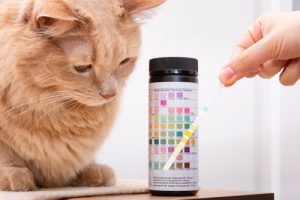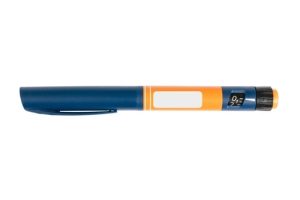Diabetes is a common illness of middle-aged to older cats. It means they can’t control their blood sugar levels. It affects around 1 in 230 cats or 0.43% of the population. Diabetes is most likely to occur in male cats over 8 years old and in the Burmese breed.
Diabetes in cats happens because of a problem with the hormone insulin and how it acts in their body. There isn’t a cure for diabetes. Untreated or uncontrolled diabetes causes life-threatening illness. But treatment with insulin and a special diet controls the condition. Your cat with diabetes can lead a full and active life. Early identification and treatment ensure the best outcomes for cats with diabetes.
Overview
What is diabetes in cats?
There are 2 sorts of diabetes in cats:
- Diabetes mellitus or ‘sugar diabetes’ – a relatively common illness in cats.
- Diabetes insipidus or ‘water diabetes’ – a rare brain illness; causes increased drinking and peeing in cats.
The term ‘diabetes’ usually means diabetes mellitus. This article looks at diabetes mellitus in cats.
Diabetes in cats explained
- All of the cells in the body use glucose as fuel to work.
- When the body needs more fuel we get hungry. So they eat, and their blood sugar levels rise.
- Insulin is a hormone that helps glucose get from the bloodstream into the cells.
- In diabetes, there isn’t enough insulin to move glucose across into the cells. Or the cells themselves can’t respond to insulin. Either way, glucose stays in the blood.
- Glucose levels in the blood get higher, but the body still needs fuel.
- Hunger increases, but eating more doesn’t help. So the body starts using its own fat and muscle to try to provide fuel.
Insulin comes from special cells called ‘islet cells’ in your cat’s pancreas. The pancreas is a small gland in your cat’s tummy.
There are two types of diabetes:
Type 1 Diabetes
- Rare in cats, about 1 in 20 diabetes cases are type 1
- It happens due to a gene defect or chronic pancreatitis
- Insulin-dependent diabetes: the body doesn’t produce enough insulin
- The body’s own defence system attacks the pancreas by mistake and destroys the islet cells
- Insulin levels drop and blood glucose levels rise
Type 2 Diabetes
- Accounts for over 90% of diabetes in cats
- Possible causes include: other illnesses, certain medications, and obesity
- Insulin-resistant diabetes: the cells can’t respond properly to insulin
- The pancreas produces more and more insulin to compensate
- Eventually, the Islet cells are completely exhausted and stop producing any insulin
- There’s not enough insulin to meet demand and blood glucose rises
Complications of diabetes mellitus in cats
Untreated or poorly controlled diabetes leads to diabetic ketoacidosis (DKA). This is a much more severe and life-threatening illness.
On the other hand, having too much insulin for the amount of sugar in the blood can lead to dangerously low blood sugar levels, called hypoglycaemia.
Symptoms
What are the symptoms of diabetes in cats?
Cats with diabetes have lots of sugar in their blood, but it stays there. Trapped. And if this goes on for any length of time, rising blood sugar and lack of essential energy inside cells leads to all the symptoms of diabetes.
- Drinking more
- Peeing more
- Losing weight and muscle
- Eating more
- Sleeping more
- Developing a poorer coat
- Walking ‘crouched’ on back legs
Risk
Diabetes in cats: which cats are most at risk?
Although any cat can develop diabetes, some things do increase their risk:
- Sex: male cats
- Age: over 8 years old
- Overweight (obese) and inactive
- Diet: Eating dry food
- Breed: Burmese cats have an inherited risk of diabetes
- Having other illnesses, such as chronic or recurrent pancreatitis, and acromegaly (having too much ‘growth hormone’)
- Certain medications: steroid anti-inflammatory medicines (for feline asthma or skin allergies). Steroid hormone treatments (for skin disease or behavioural problems)
Other health risks for cats with diabetes mellitus
- Cystitis: bladder infections and inflammation; sugar in the urine encourages bacteria to multiply
- Going blind: cats with poorly-controlled diabetes will develop cataracts
- Recurrent infections: diabetes weakens your cat’s immune defences. They’re more likely to get urinary tract and skin infections and dental disease.
Are my other pets or family at risk?
- Diabetes affects individual cats. It won’t spread to other animals or humans.
- Cats in the same household with the same risk factors will be equally at risk of diabetes.
Diagnosis
How do vets diagnose diabetes in cats?
Vets usually diagnose diabetes in cats based on the following:
- History: changes and problems you report, including other illnesses and treatments.
- Physical exam: checking body condition, clues to underlying illness, eye exam (cataracts)
- Urine tests: using a special test strip to detect how much glucose is present. The same strip also detects ketones, which are a sign of severe or poorly controlled diabetes.
- Blood tests: glucose and fructosamine (a chemical that tells how well glucose levels were controlled in the previous month).
Vets diagnose and manage diabetes based on all of the above. No single test provides a definite answer.

Vet treatment
What’s the treatment for diabetes mellitus in cats?
Cats with diabetes are likely to need insulin injections every day for life. Treating diabetes is a major commitment for owners. So it’s important that you understand what’s involved from the beginning. Your vet can help with this.
The treatment goals for diabetes in cats:
- Controlling or preventing symptoms.
- Maintaining a healthy weight and appetite.
- Helping your cat and you to continue to play and enjoy life together.
Treatment for diabetes – what’s involved?
- Insulin injections every 12 hours to control blood glucose
- A blood glucose curve helps your vet work out the dose of insulin that your cat needs to control their symptoms
- Diet planning and managing body weight
- Antibiotics if infections are present
Giving insulin injections to your diabetic cat:
- If your cat has diabetes, you’ll need to give them their insulin injections.
- Your vet or vet nurse will show you how to do it and help you until you feel confident.
- Pre-set insulin injector pens are available. These are easier to use than an injection and give a reliable dose. But they’re also going to be more expensive.

Other treatment options?
Treatments (pills) given by mouth for diabetes are rarely used for diabetic cats at the moment. They’re not very effective. But a new tablet may offer an alternative treatment option when it becomes available in the UK.
Senvelgo (Boehringer Ingelheim) is a new treatment given by mouth that reduces blood glucose by helping the body get rid of extra glucose in urine (pee). But it can only be used in younger cats with diabetes who are otherwise very healthy. It’s completely unsuitable for cats:
- With other illnesses
- Who have had insulin injections in the past
- Who show any symptoms or risks of diabetic ketoacidosis
Costs of treating diabetes in cats
Ongoing costs after diagnosis and stabilisation include:
- Medication: insulin
- Syringes and needles
- Vet checks every 3-6 months
- Regular blood and urine tests for monitoring control
- Possible additional checks and hospital treatment for complications or changes in insulin requirements
Diabetes is most often a lifelong condition, and treating it will be expensive over your cat’s lifetime.
Sometimes diabetic cats don’t need insulin once their weight and diet are controlled. It’s not so much a cure as a period of ‘remission’, where symptoms subside. This can be achieved in about 25-30% of diabetic cats. And it may last as long as weight, diet and lifestyle remain well controlled.
Talk everything through thoroughly with your vet before starting your cat’s treatment. It’s much better to raise any concerns openly at the outset and to ask for help or guidance.
Home treatment
Living with a diabetic cat at home
Caring successfully for your diabetic cat means keeping to a regular routine of feeding, insulin treatment and weight management. Here’s what you need to do:
- Ensure your cat gets their insulin injections at the correct dose and time.
- Feed a prescription diet for diabetes regularly throughout the day. Hills Prescription Diet Diabetes Care m/d is ideal.
- Check your cat’s weight regularly and keep them slim to make control easier.
Body Condition Score (BCS) is a scale that gives a practical evaluation of the fat coverage of your cat’s body. By checking how easy or not it is to feel certain bony areas of the body, a score is then produced. There are several scales, from 1 to 5 or 1 to 9. The ideal body condition lies in the middle, so either 3/5 or 5/9. The body areas normally checked for fat coverage are: 1. ribs and spine 2. hips and shoulders 3. waist Here are a few tips on how to do it. With your pet in a standing position:
Body Condition Scoring (BCS) in cats

- Keep up to date with preventive care: vaccination, worming and flea treatments.
- Identify and treat other health problems promptly.
- Attend regular check-ups with a vet to make sure that diabetes is under control.
It’s a good idea to keep a diary of medication, feeding and behaviour and review it every week.
Monitoring your cat with diabetes at home
Sometimes your vet may suggest checking your cat’s diabetes control at home. This includes:
- Testing urine: collecting a clean sample of your cat’s pee and checking for glucose and ketones with the special test strips.
- Blood testing: it’s possible to test your cat’s glucose at home. Your vet practice will show you how to take a small blood sample from your cat’s ear. Simple blood glucose monitors (glucometers) are available at chemists for human diabetics. Not every cat will tolerate this at home. They may need to have all their checks carried out at a vet practice instead.
- Continuous glucose monitoring using a new device that stays on your cat for up to 2 weeks. It monitors the glucose levels in fluid just under the skin. It’s painlessly attached by your vet and is ideal for stress-free monitoring any time of day.
Caring successfully for a diabetic cat is a big commitment. Talk everything through with your vet before starting your cat’s treatment. It’s much better to raise any concerns openly at the outset and to ask for help or guidance.
Quality of life
Most cats live a full happy life on insulin treatment. But not all respond so well. And serious complications, like diabetic ketoacidosis, are more likely as they get older and develop other illnesses. If diabetes can’t be effectively controlled for any of these reasons, your cat’s health will progressively worsen.
You may find yourself wondering if they are enjoying life any more. Joii’s Quality of Life assessment tool can help assess this.
Prevention
Can you prevent your cat from getting diabetes?
Burmese cats have an inherited risk of diabetes, which can’t be prevented.
However, obesity predisposes all cats to diabetes.
Reduce your cat’s risk of diabetes by:
- Feeding a well-balanced diet that’s suitable for their age and lifestyle.
- Keeping your cat at a healthy weight
When to worry
When to worry about your cat with diabetes
Diabetes mellitus is a serious health condition, requiring careful treatment and monitoring.
Diabetic ketoacidosis and hypoglycaemia are both life-threatening complications of diabetes. Both can come on very quickly.
Call your nearest vet if your diabetic cat is:
- Vomiting and dehydrated.
- Not eating.
- Moving oddly or trembling.
- Collapsed.
Call a practice vet if your cat is:
- Drinking and peeing (urinating) more than usual.
- Losing weight but eating more.
- Has sweet-smelling breath or urine.
Joii can help with advice on:
- Recognising symptoms of diabetes.
- How to care for a diabetic cat at home.
- Choosing the best diet for your cat.
- Managing weight loss and control.
- Quality of life








